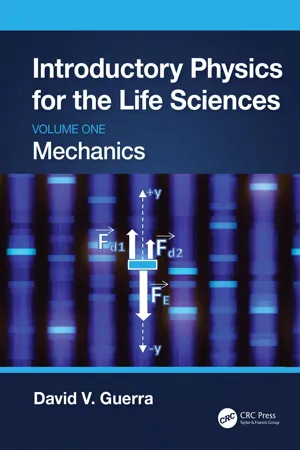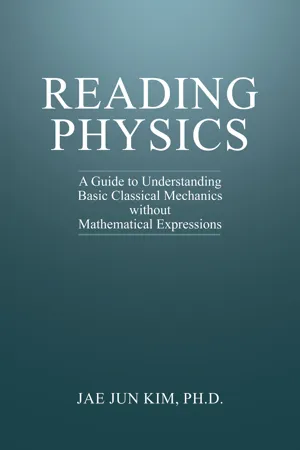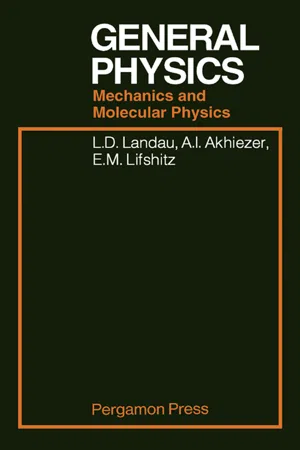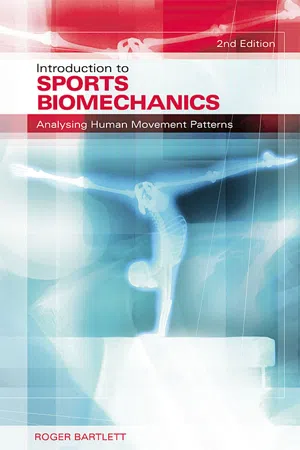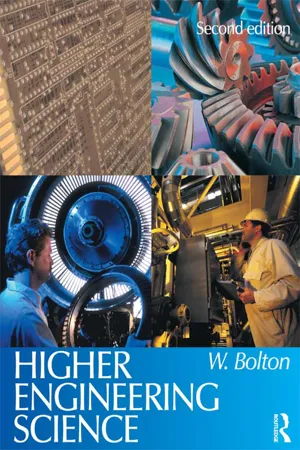Physics
Torque and Rotational Motion
Torque is the measure of the rotational force applied to an object, causing it to rotate around an axis. It is calculated as the product of the force and the distance from the axis of rotation. Rotational motion refers to the movement of an object around an axis, and is characterized by concepts such as angular velocity, angular acceleration, and moment of inertia.
Written by Perlego with AI-assistance
Related key terms
8 Key excerpts on "Torque and Rotational Motion"
- No longer available |Learn more
- Robert A. Pelcovits, Joshua Farkas(Authors)
- 2023(Publication Date)
- Barrons Educational Services(Publisher)
torque is the ability of a force to cause an object to accelerate angularly (i.e., to rotate at a nonconstant angular velocity). Torque is the angular analog of force. Mathematically,Here r is defined as a relative position vector pointing from the axis of rotation to the point where the force is applied (which requires that torque be calculated about some specified axis). The angle θ is defined as the angle between the position and force vectors when they are placed tail to tail. It makes sense that this cross product determines the rotation that the force imparts:1.Clearly, the rotation produced should be proportional to the magnitude of the force.2.It makes sense that the torque is proportional to the magnitude of r: Forces acting at greater radial distances from the axis (greater “lever arms”) exert more torque. If you don’t believe this, try closing a door by pushing on it close to the hinges.3.The torque also depends on the angle between F and r; torque is maximized when the force is perpendicular to r and is zero when it is parallel or antiparallel. This also makes sense: Try closing a door by pushing or pulling the door away from its hinges.The units of torque are force ⋅ length, generally newton meters (N⋅m).Computing Torque in Problems
1.Magnitude: Recall from Chapter 1 that the magnitude of the cross product is equal to the length of either vector multiplied by the projection of the other vector perpendicular to the first vector. In practice, it is often easiest to calculate the magnitude of the torque this way (designating F⊥ the component of the force perpendicular to r, and r⊥ the component of r perpendicular to F).Based on the situation, it may be easier to compute F⊥ and r or r⊥ and F.2.Direction: - David V. Guerra(Author)
- 2023(Publication Date)
- CRC Press(Publisher)
3 Torque and Rotational Equilibrium
DOI: 10.1201/9781003308065-33.1 Introduction
In some situations, a force is applied using a tool like a wrench or a screwdriver and a twisting force, called a torque, is produced. These twisting forces are central to the understanding and analysis of some objects in equilibrium. In this chapter, the concepts of torque will be studied and then applied to the analysis of systems in rotational equilibrium.- Chapter question: A person suspends a block of mass m from his or her hand, as depicted in Figure 3.1 .
FIGURE 3.1 Diagram of an arm.Assuming their forearm has a mass mA , is the force of tension in their bicep muscle equal to, greater than, or less than the sum of the weight of their arm and the weight of the object? To answer this question, the concepts of torque and rotational equilibrium will be developed and they will be applied at the end of this chapter to answer this question.
3.2 Torque
Torque is a twisting force, which is denoted by the Greek letter tau (τ). When opening the lid of a jar, the more force you apply the more twisting force (torque) you apply to open the jar. As you may also know from experience, if you are trying to loosen or tighten a bolt with a wrench, the harder you pull on the wrench, the force (F), the more torque there is on the bolt. But sometimes the bolt will not loosen no matter how hard you pull on the wrench. To loosen the bolt you can get a longer wrench or even slip a pipe on the end of the wrench. So, it is clear that the torque depends not only on the force applied but also on the distance away from the rotation point at which the force is applied.In the previous example, the angle between the force and the distance away from the rotation point is assumed to be perpendicular as shown in Figure 3.2 , but that is not always the case. So, the torque (τ) is defined as the product of the applied force (F) and the perpendicular distance (r ⊥- eBook - ePub
Reading Physics
A Guide to Understanding Basic Classical Mechanics without Mathematical Expressions
- Jae J. Kim(Author)
- 2023(Publication Date)
- Universal Publishers(Publisher)
How about a quantity that corresponds to “work done” in a rotational motion? Can we realize the “work done” in a system when having a rotational motion? We may not, and that is because the part of displacement that is parallel to the direction of the force only matters when it comes down to the work done by or to a system. However, in a rotational motion, we do not have such a component, if you remember. The component of the displacement that is “not parallel” to the force is all we have in a rotational motion. Going back to one of the previous lessons, you are going to hold a string hard to keep a piece of plastic in a rotation motion; the direction associated with the force is toward the center of the motion, whereas the direction of the displacement is perpendicular to that of the force. Point: we cannot realize “work done” in a rotational motion. That is just part of the definition. At the same time, the part that is not realized as a part of work done needs to be addressed, and that is exactly what “torque” is in a rotational motion. You take the force and the component of the displacement not parallel to the force and take what we call “cross-product” of the two in mathematics, and that will give us the size of the torque.The component that is parallel to the direction of the force contributes to the work done to or by the system, whereas that which is not parallel to that of the force goes down to torque in a rotational motion.Figures 36.1 and 36.2 illustrate the points well. In any case, you may want to think about opening a door. Imagine you have a large door, and you push the door in a way that the direction of the force is parallel to the direction of the door. Can you push the door to get it open or not? If you can, I may need to have a chat with you because I tried to do so, and I could not get it open no matter how many times I tried it.Figure 36.1: Imagine that you have a door, and you push it in a way that the direction of the force being applied is parallel to that of the door. Question: can you open the door or not?Figure 36.2: If you push the door parallel to the direction of the door, you are not going to be able to open it. Instead, you need to push it from the front, as illustrated on the left side of the figure. That way the direction of the force is not parallel to the direction of the door, and the door is going to start rotating with respect to its axis and you are going to open the door. That is how you apply torque to the object, not do work to the object.Remember: - eBook - ePub
General Physics
Mechanics and Molecular Physics
- L D Landau(Author)
- 2013(Publication Date)
- Pergamon(Publisher)
We may also note that the point of application of a force in a rigid body may be displaced in any manner along its line of action without affecting the properties of the motion. This will evidently leave unchanged the arm of the force and therefore the torque.The condition for equilibrium of a body which can rotate about an axis is evidently that the sum of the torques acting on it should be zero. This is the law of torques (or law of moments ). A particular case is the familiar lever rule which gives the condition of equilibrium for a rod able to rotate about one point in it.There is a simple relation between the torque acting on a body and the work done in a rotation of the body. The work done by a force F when the body rotates about the axis through an infinitesimal angle dφ (Fig. 28 ) is equal to the product of the displacement ds = rdφ of the point A where the force is applied and the componentFs= F sin θ of the force in the direction of motion:F sd s = F r sin θ d φ =K zd φ .We see that the torque about the axis is equal to the work done per unit angular displacement. On the other hand, the work done on the body is equal to the decrease in its potential energy. We can therefore putKz dφ= –dU , orK z= − d U / d φ .Thus the torque is equal to minus the derivative of the potential energy with respect to the angle of rotation of the body about the given axis. The analogy between this relation and the formula F = –dU /dx should be noticed; the latter relates the force to the change in potential energy in motion of a particle or translational motion of a body.It is easy to see that the equation of motion of a rotating body is, as it should be, in accordance with the law of conservation of energy. The total energy of the body isE =and its conservation is expressed by the equation1 2IΩ 2+ U ,From the rule for differentiating a function of a function we havedd t(= 0.)1 2IΩ 2+ U=d Ud td Ud φ= −d φd tK zΩ .The derivative d Ω2 /dt = 2Ω d Ω/dt . Substituting these expressions and cancelling the common factor Ω, we again obtain the equation Id Ω/dt =Kz - eBook - ePub
Introduction to Sports Biomechanics
Analysing Human Movement Patterns
- Roger Bartlett(Author)
- 2007(Publication Date)
- Routledge(Publisher)
Figure 5.1 .The effects of a force are not altered by moving it along its line of action. Its effects on rotation – though not on linear motion – are changed if the force is moved parallel to the original direction and away from its line of action. A torque, also known as aFigure 5.1 Directional quality of force.moment of force or a turning effect, is then introduced; this is an effect tending to rotate the object (see below). A quantitative analyst should exercise care when solving systems of forces graphically and would usually adopt a vector approach (see Appendix 4.1 ).The SI unit of force is the newton (N) and the symbol for a force vector is F . One newton is the force that when applied to a mass of one kilogram (1 kg), causes that mass to accelerate at 1 m/s2 in the direction of the force application. A sports performer experiences forces both internal to and external to the body. Internal forces are generated by the muscles and transmitted by tendons, bones, ligaments and cartilage; these will be considered in Chapter 6 . The main external forces, the combined effect of which determines the overall motion of the body, are as follows.Weight
Weight is a familiar force (Figure 5.1 ) attributable to the gravitational pull of the Earth. It acts vertically downwards through the centre of gravity of an object towards the centre of the Earth. The centre of gravity (G in Figure 5.1 ) is an imaginary point at which the weight of an object can be considered to act. For the human performer, there is little difference between the positions of the centre of mass (see later) and the centre of gravity. The former is the term preferred in most modern sports biomechanics literature and will be used in the rest of this book. One reason for this preference is that the centre of gravity is a meaningless concept in weightless environments, such as space shuttles. An athlete with a mass of 50 kg has a weight (G ) of about 490 N at sea level, at which the standard value of gravitational acceleration, g , is assumed to be 9.81 m/s2 - eBook - ePub
- William Bolton(Author)
- 2012(Publication Date)
- Routledge(Publisher)
4 Linear and angular motion 4.1 Introduction This chapter is concerned with the behaviour of dynamic mechanical systems when there is uniform acceleration. The terms and basic equations associated with linear motion with uniform acceleration and angular motion with uniform angular acceleration, Newton’s laws of motion, moment of inertia and the effects of friction are revised and applied to the solution of mechanical system problems. The terms scalar quantity and vector quantity are used in this chapter, so as a point of revision: Scalar quantities are those that only need to have their size to be given in order for their effects to be determined, e.g. mass. Vector quantities are those that need to have both their size and direction to be given in order for their effects to be determined, e.g. force where we need to know the direction as well as the size to determine its effect. 4.2 Linear motion The following are basic terms used in the description of linear motion, i.e. motion that occurs in a straight line path rather than rotation which we will consider later in this chapter: 1 Distance and displacement The term distance tends to be used for distances measured along the path of an object, whatever form the path takes; the term displacement, however, tends to be used for the distance travelled in a particular straight line direction (Figure 4.1). For example, if an object moves in a circular path the distance travelled is the circumference of the path whereas the displacement might be zero if it ends up at the same point it started from - eBook - ePub
- A. L. Stanford, J. M. Tanner(Authors)
- 2014(Publication Date)
- Academic Press(Publisher)
r α relate the translational and rotational variables of points on or within the rolling body. Special properties of the center of mass of a rigid body permit us to treat a body rolling without slipping in a simple fashion:1. We may calculate the net torque ∑τcm about the center of mass of the body, use its moment of inertiaIcmabout an axis through its center of mass, and treat the problem dynamically using ∑τcm =Icmα and ∑F = M a cm , in whichacm= r α.2. We may write the kinetic energy K of the body as K = 1/2Icmω2 + 1/2Mv 2 cm , in whichvcm= r ω.How do we distinguish between rotational problems that are appropriately treated by kinematics or dynamics or energetics? The issue is kinematic if a given problem requires us to relate any of the quantities θ, ω, α, and t among themselves. If the angular acceleration of a system is constant, the equations that relate the rotational kinematic quantities areθ =θ o+ω ot +1 2αt 2ω =ω o+ α tω 2=ω o 2+ 2 α ( θ −θ o)Rotational dynamics problems relate the net torque on a body, its moment of inertia, and its angular acceleration according to ∑τ = Iα . Problems in which we seek torque or angular acceleration (or their corresponding forces or translational acceleration) are usually handled conveniently using rotational dynamics, that is, using ∑τ = Iα . On the other hand, rotational problems that specifically ask for the speed of a body (or its corresponding angular velocity) when the body moves through a vertical distance, exchanging gravitational potential energy and kinetic energy, we should consider using the conservation of energy principle.The correspondence between rotational variables and translational variables permits us to construct appropriate rotational relationships from familiar translational relationships. The following tabulation recalls the correspondence between the variables of translation and rotation: - eBook - ePub
Introductory Physics
Summaries, Examples, and Practice Problems
- Michael Antosh(Author)
- 2023(Publication Date)
- CRC Press(Publisher)
Rotation Motion and ForcesDOI: 10.1201/9781003005049-99.1 Introduction: Rotational Motion is Like Linear Motion
Chapters 9 and 10 are about rotational motion, meaning things that rotate in a circle. Even though this motion looks different, you will see that the math is very similar to things we’ve done before.One example of this: instead of position being something that changes with motion, it is replaced with angle. Then, instead of velocity (how much the distance is changing with time), you will have an angular velocity, which is how much the angle is changing with time.We will end up repeating many of the things we have done before, including the equations from Chapter 2 that describe motion, and Newton’s second law from Chapter 4 . In a way, it will be like reviewing almost everything that we have already done.9.2 Units for Angle: Radians and Revolutions
The physics equations for rotation done in Chapters 9 and 10 will assume that the angles are in the unit of radians (rad). The unit conversion is:180 degrees = π radians(9.2.1)π is approximately equal to 3.14. Another unit for angle that is used often is revolutions (rev). The conversion is:360 degrees = 1 revolution(9.2.2)This conversion is because 1 revolution is the number of degrees in a full circle. You can combine Equations 9.2.1 and 9.2.2 to get a conversion between radians and revolutions:1 revolution = 2∙π radians(9.2.3)Example 9.2.1Convert 279 degrees to (A) radians and to (B) revolutions.- A. 279 degrees ⋅= 4.87 radπ radians180 degrees
- B. 279 degrees ⋅= 0.775 rev1 revolution360 degrees
Problem to Try YourselfA snowboarder does a “1080”, covering 1080 degrees, which is three full turns. What is this angle in radians and in revolutions?”
Index pages curate the most relevant extracts from our library of academic textbooks. They’ve been created using an in-house natural language model (NLM), each adding context and meaning to key research topics.

